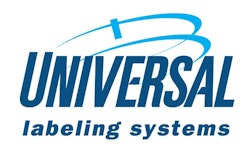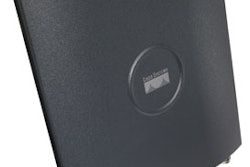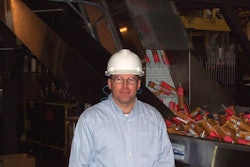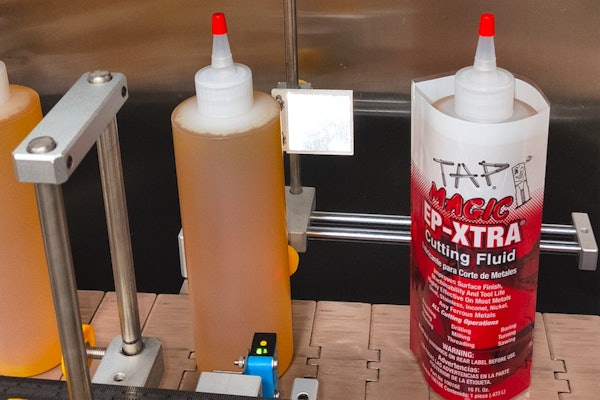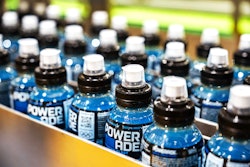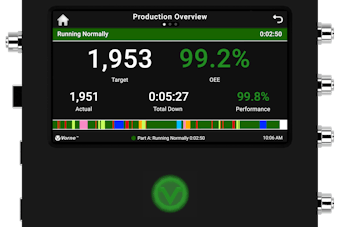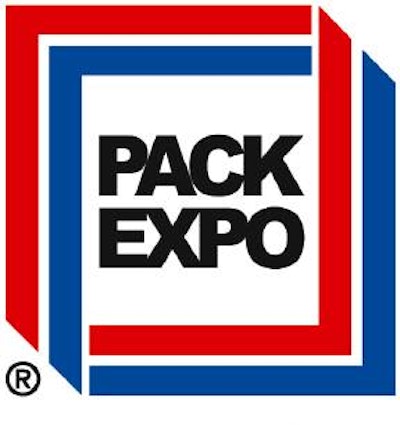
Thanks to digital publishing, blogs, Internet postings, and podcasts,
tradeshow reviews become available in quick abundance, leaving less
uncharted ground for later ones. For that reason, and in deference to
the informative reviews others
already have provided (see Packaging World's coverage of Pack Expo.
Intl. 2008), this article takes a hybrid approach: a perspective that's part review, part retrospective, part preview.
Not, “It’s the economy, stupid”; rather, “It’s the stupid economy.”
Every Pack Expo has lived up to its reputation as the primo U.S. event in packaging, and last month's annual staging in Chicago's McCormick Place was no exception. What was exceptional, however, was the backdrop; Pack Expo '08 was conducted under an economic climate worse than that faced by any previous Expo. Happily, by early reports, neither attendance nor exhibitors dropped proportionately, possibly due in part to commitments made before the financial crisis hit.
Beset times nonwithstanding, Pack Expo '08 was a testament to the acknowledged role of packaging as a strategic tool. It’s a role that will have to be played out innovatively, because the times will exert themselves unevenly across segments of the user and supplier industries. Plans for new machinery installations, for example, will be shelved by some users who have less access to tightened lending sources and who can’t (or choose not to) self-finance.
Such companies can explore possibilities in rebuilding, retrofitting, or otherwise modifying their machinery to improve productivity and quality at reduced operating costs. Another avenue is analyzing the plant layout, not only focusing on machine cycle times, but also on how the infeed and outfeed stations can be improved.
And, while some OEM’s are sure to experience a pinch, the contract packaging sector might fare handsomely, as users turn to them as alternatives to new machinery. The point is that no packaging user has to be stagnant throughout a recession.
Even the more optimistic forecasters say that an economic turnaround is a couple of years away, which coincides with the return of Pack Expo to Chicago in 2010. How those numbers will compare to those of '08 will be reflective of the ingenuity and flexibility that users and suppliers show during the interim. In that sense, '08 and its aftermath will serve as benchmarks for measuring the vitality of the packaging function.
Being trendy
To view Pack Expo as an event for discovering trends is somewhat misleading. The exhibition and conference are trend-driven, and success is predicated on marketing the event as the one-stop for encountering those trends in a multitude of embodiments and interpretations. Sustainability, RFID, mechatronics, robotics, supply-chain management, smart packaging, etc., are concepts already known to most packaging professionals. What they seek through their attendance are contacts, insights, and serendipity to help bridge theory and practice, concept and application.
Pack Expo '08 deserves plaudits for how its promotion featured all the top trends as well as for its fine job of grouping them into pavilions. Furthermore, the sprawl of McCormick Place was rendered far more navigable by Total Access and My Pack Expo, which allowed attendees to map routes in accordance with specific interests.
There is value in knowing a trend, additional value in seeing examples in the forms of machinery, materials, containers, and services; however, the real differentiator can be the ability to extrapolate—to chart a trend's trajectory for strategic purposes. Robotics, for example, has become a common component of palletizing machinery, with a growing capability for heterogeneous loads. It’s part of an overall trend toward automation and its advantages over manual labor relative to costs, consistency, and quality.
Now, assume a packager that wants to investigate robotizing upstream operations, such as the unpacking of empty containers and the case loading of filled containers. That company should cast the widest net, beyond traditional supply sources. There’s a large segment of the robotics industry, formerly specializing in the auto industry, that is looking for new industries and new applications, in the wake of the continuing downsizing of the Big Three automakers. Some of those suppliers may prove to be future members of PMMI.
Pack Expo '08 did a remarkable job in identifying, promoting, and presenting the trends. What it can never do for the attendee, though, is provide prepackaged solutions to opportunities and challenges. Turnkey answers are seldom to be had because packaging requires the marriage of disparate components, necessitating customized approaches.
Sustainability: Can we keep it going?
There was no mistaking the overarching theme. Pack Expo '08 has the distinction of having been the first of the exposition's iterations to take place since sustainability has evolved into the dominant concern in packaging and the first since the implementation of the Wal-Mart Scorecard. Many exhibitors chatted up attendees on the theme. The conference track and the keynote sessions, together, provided an appreciation for the multifaceted nature and all-encompassing reach of sustainability.
It’s precisely those characteristics that guarantee that sustainability will remain the principle focus of future Pack Expos. Therein lies a challenge: What’s the best way to give the theme serial coverage? Furthermore, over the years, there will be a continuous parade of anecdotal success stories. We must go beyond, and Pack Expo can lead the charge against the coverage of sustainability lapsing into predictability and sameness.
One step in that direction would be to broaden the dialogue. A voice that needs to be included is that of government, sure, but particularly a certain type: the municipalities—large and small—that have singled out certain packaging materials and containers as targets of expedient bans, supposedly for environmental purposes. Let one of those mayors or councilpersons give a keynote session to a Pack Expo audience and defend (assuming that they can) those decisions. The ensuing exchanges have the potential of promoting mutual understanding and respect.
One another note, sustainability frequently is expressed in numbers and equivalencies, for example, x-number of trucks taken off the roads or x-tons of carbon dioxide removed from the atmosphere. Given the importance of metrics, is there a way to bring a real-time version to the exhibit floor? What if a future Pack Expo were to provide a system that gives continuous, reader-friendly readout of the energy being consumed by a machine as it's running on the exhibit floor? Attendees would have a means of comparison, however rough. Blue-sky thinking? Maybe, but worth considering.
To its credit, Pack Expo (reflecting packaging user and supplier industries) has shown environmental awareness for decades prior to the sustainability era. One example serves for many: Pack Expo 1988 had a conference track under the heading, “Environment,” which featured eight presentations, each of which has present relevance. So, by its history and because its patrons are directly affected, Pack Expo is credentialed to be a sustainability innovator.
Now we mark our calendars for next year and Pack Expo Las Vegas. Whatever the themes, whatever the program, the event will do prideful service to the packaging function. And, in a city that owes its existence to wagering, there will be no surer bet.
Before becoming a packaging consultant, Sterling Anthony worked for Fortune 500 food, healthcare, and automotive companies, and has taught packaging at the university level. He welcomes your comments by phone, 313/531-1875 or by e-mail, [email protected]
His Web site is www.pkgconsultant.com
Not, “It’s the economy, stupid”; rather, “It’s the stupid economy.”
Every Pack Expo has lived up to its reputation as the primo U.S. event in packaging, and last month's annual staging in Chicago's McCormick Place was no exception. What was exceptional, however, was the backdrop; Pack Expo '08 was conducted under an economic climate worse than that faced by any previous Expo. Happily, by early reports, neither attendance nor exhibitors dropped proportionately, possibly due in part to commitments made before the financial crisis hit.
Beset times nonwithstanding, Pack Expo '08 was a testament to the acknowledged role of packaging as a strategic tool. It’s a role that will have to be played out innovatively, because the times will exert themselves unevenly across segments of the user and supplier industries. Plans for new machinery installations, for example, will be shelved by some users who have less access to tightened lending sources and who can’t (or choose not to) self-finance.
Such companies can explore possibilities in rebuilding, retrofitting, or otherwise modifying their machinery to improve productivity and quality at reduced operating costs. Another avenue is analyzing the plant layout, not only focusing on machine cycle times, but also on how the infeed and outfeed stations can be improved.
And, while some OEM’s are sure to experience a pinch, the contract packaging sector might fare handsomely, as users turn to them as alternatives to new machinery. The point is that no packaging user has to be stagnant throughout a recession.
Even the more optimistic forecasters say that an economic turnaround is a couple of years away, which coincides with the return of Pack Expo to Chicago in 2010. How those numbers will compare to those of '08 will be reflective of the ingenuity and flexibility that users and suppliers show during the interim. In that sense, '08 and its aftermath will serve as benchmarks for measuring the vitality of the packaging function.
Being trendy
To view Pack Expo as an event for discovering trends is somewhat misleading. The exhibition and conference are trend-driven, and success is predicated on marketing the event as the one-stop for encountering those trends in a multitude of embodiments and interpretations. Sustainability, RFID, mechatronics, robotics, supply-chain management, smart packaging, etc., are concepts already known to most packaging professionals. What they seek through their attendance are contacts, insights, and serendipity to help bridge theory and practice, concept and application.
Pack Expo '08 deserves plaudits for how its promotion featured all the top trends as well as for its fine job of grouping them into pavilions. Furthermore, the sprawl of McCormick Place was rendered far more navigable by Total Access and My Pack Expo, which allowed attendees to map routes in accordance with specific interests.
There is value in knowing a trend, additional value in seeing examples in the forms of machinery, materials, containers, and services; however, the real differentiator can be the ability to extrapolate—to chart a trend's trajectory for strategic purposes. Robotics, for example, has become a common component of palletizing machinery, with a growing capability for heterogeneous loads. It’s part of an overall trend toward automation and its advantages over manual labor relative to costs, consistency, and quality.
Now, assume a packager that wants to investigate robotizing upstream operations, such as the unpacking of empty containers and the case loading of filled containers. That company should cast the widest net, beyond traditional supply sources. There’s a large segment of the robotics industry, formerly specializing in the auto industry, that is looking for new industries and new applications, in the wake of the continuing downsizing of the Big Three automakers. Some of those suppliers may prove to be future members of PMMI.
Pack Expo '08 did a remarkable job in identifying, promoting, and presenting the trends. What it can never do for the attendee, though, is provide prepackaged solutions to opportunities and challenges. Turnkey answers are seldom to be had because packaging requires the marriage of disparate components, necessitating customized approaches.
Sustainability: Can we keep it going?
There was no mistaking the overarching theme. Pack Expo '08 has the distinction of having been the first of the exposition's iterations to take place since sustainability has evolved into the dominant concern in packaging and the first since the implementation of the Wal-Mart Scorecard. Many exhibitors chatted up attendees on the theme. The conference track and the keynote sessions, together, provided an appreciation for the multifaceted nature and all-encompassing reach of sustainability.
It’s precisely those characteristics that guarantee that sustainability will remain the principle focus of future Pack Expos. Therein lies a challenge: What’s the best way to give the theme serial coverage? Furthermore, over the years, there will be a continuous parade of anecdotal success stories. We must go beyond, and Pack Expo can lead the charge against the coverage of sustainability lapsing into predictability and sameness.
One step in that direction would be to broaden the dialogue. A voice that needs to be included is that of government, sure, but particularly a certain type: the municipalities—large and small—that have singled out certain packaging materials and containers as targets of expedient bans, supposedly for environmental purposes. Let one of those mayors or councilpersons give a keynote session to a Pack Expo audience and defend (assuming that they can) those decisions. The ensuing exchanges have the potential of promoting mutual understanding and respect.
One another note, sustainability frequently is expressed in numbers and equivalencies, for example, x-number of trucks taken off the roads or x-tons of carbon dioxide removed from the atmosphere. Given the importance of metrics, is there a way to bring a real-time version to the exhibit floor? What if a future Pack Expo were to provide a system that gives continuous, reader-friendly readout of the energy being consumed by a machine as it's running on the exhibit floor? Attendees would have a means of comparison, however rough. Blue-sky thinking? Maybe, but worth considering.
To its credit, Pack Expo (reflecting packaging user and supplier industries) has shown environmental awareness for decades prior to the sustainability era. One example serves for many: Pack Expo 1988 had a conference track under the heading, “Environment,” which featured eight presentations, each of which has present relevance. So, by its history and because its patrons are directly affected, Pack Expo is credentialed to be a sustainability innovator.
Now we mark our calendars for next year and Pack Expo Las Vegas. Whatever the themes, whatever the program, the event will do prideful service to the packaging function. And, in a city that owes its existence to wagering, there will be no surer bet.
Before becoming a packaging consultant, Sterling Anthony worked for Fortune 500 food, healthcare, and automotive companies, and has taught packaging at the university level. He welcomes your comments by phone, 313/531-1875 or by e-mail, [email protected]
His Web site is www.pkgconsultant.com
Companies in this article
Videos from Universal Labeling Systems, Inc.




